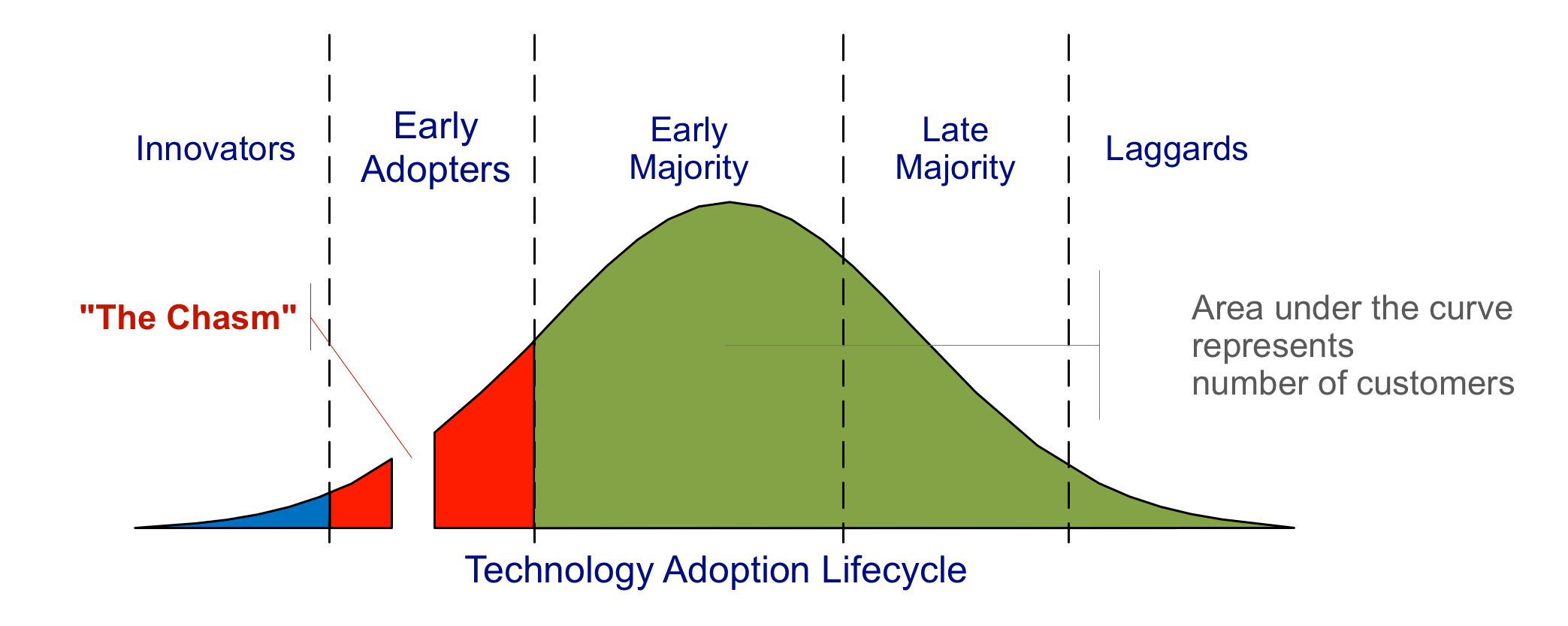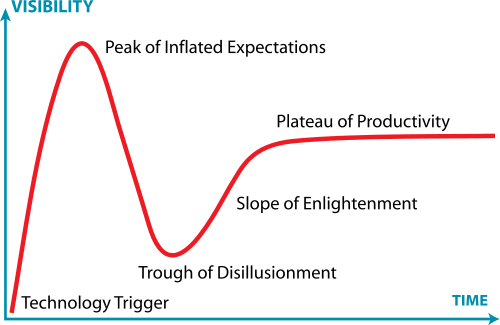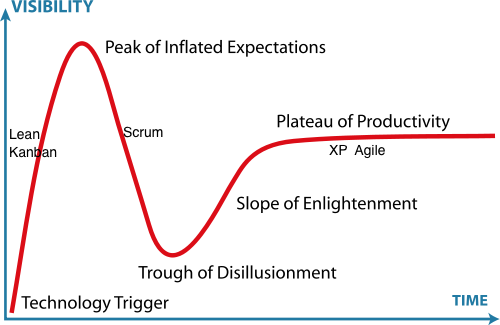The good news is that Agile has crossed the chasm (Moore, 1991). On the down side there has been, and is, a lot of hype and hyperbole around Agile, Lean, Scrum, XP and Kanban, etc, etc. In particular, and despite the Agile Manifesto, the meaning of the term "Agile" has become very diffuse. So much so that there are many people, like a colleague of mine and one time Agile fan, who now says "I don’t talk about ‘Agile’ any more; it doesn’t mean anything".
I find the hype annoying, and Agile’s loss of meaning exasperating, but I also think it an inevitable part of progress.
Crossing the Chasm
Since I mentioned Crossing the Chasm (Moore, 1991) I thought I should explain it. Moore’s technology adoption lifecycle has five main segments:
- innovators
- early adopters
- early majority
- late majority
- laggards

The "Chasm" in the name of the book occurs in the early adopters phase. Moore’s theories are applicable for disruptive or discontinuous innovations that force a significant change of behaviour (Wikipedia: Crossing the Chasm). And he is interested in market adoption of technology.
Okay Agile isn’t a technology but it is a disruptive innovation forcing a significant change of behaviour so I think applying the model is safe enough. For me the Agile innovators were the people using the various Agile practices before the term Agile was coined. It also includes the founders of DSDM, XP, and Scrum and the authors of the Agile Manifesto. I guess I was an early adopter … one of those who bought the books around 2000, learned the practices, and then went to it. I believe Agile is now long past the chasm. In fact I think Agile software development, in one form or another, is the mainstream so we’re probably in the Late Majority stage. But there are still some Laggards out there.
During Agile’s progression through those stages there was lots going on. The gurus were on the speaking circuit to push their books and consultancy businesses (still are). Agile got lots of media attention and some outrageous claims were made, and refuted, and made again (still happening). Variations crop up and new gurus push their own cart (still do). And, of course, more and more people piled onto the bandwagon (still are). And while the community grew, the meaning of Agile waned.
Semantic Diffusion
Martin Fowler has coined a term, Semantic Diffusion, for the process where a term loses its original meaning and then resurfaces in a backlash. "Agile", along with "Web2.0", was the phrase he had in mind when describing this process. But we are seeing it for other terms as well.
Semantic diffusion occurs when you have a word that is coined a person or group, often with a pretty good definition, but then gets spread through the wider community in a way that weakens that definition. This weakening risks losing the definition entirely – and with it any usefulness to the term.
Semantic diffusion is essentially a succession of Chinese whispers where a different group of people to the originators of a term start talking about it without being careful about following the original definition. These people are listened to by a further group which then goes on to add their own distortions. After a few of these hand-offs it’s easy to lose a lot of the key meaning of the term unless you make the point of going back to the originators. It’s ironic that it’s popular terms that tend to suffer from this the most. That’s inevitable, of course, since unpopular terms have less people to create the Chinese whisper chains.
Martin Fowler claims semantic diffusion coincides with hype phase of an idea. The Chinese whispers, the distortion that comes with the whispers, and the volume of distortion was all part of the hype around Agile. Or, put another way, as the hype increased the meaning of Agile waned.
Hype Cycle
Gartner have modelled the hype profile of a new technology (Wikipedia: Hype Cycle).

Gartner claim that technology goes through several phases
- Technology Trigger
- Peak of Inflated Expectations
- Trough of Disillusionment
- Slope of Enlightenment
- Plateau of Productivity
It is worth mentioning that the "Hype Cycle" has been criticised on a number of points including that it is not scientific and not actually a cycle at all.
Despite these criticisms, and the fact that the model is for technology, some have asked Where is Agile in the Hype Cycle? Actually you can ask the same question about the off-shoots like XP, Scrum, Lean and Kanban. In the next diagram I’ve overlaid where I think these approaches are in terms of hype. Lean and its high profile child, Kanban, are the new rising stars. They’re attracting a lot of attention and increasing hype. Scrum was the last great fad; expectations are still high, with associated high levels of hyperbole, but it is losing adherents to disillusionment (see, for example, Agile Anarchy: Scrum, enough already). I’ve rate XP on the Plateau of Productivity because, although it doesn’t attract much attention as a method, its technical practices are nearly universal. I’ve put Agile is the same place because, as I said, I believe it is mainstream.

Final Thoughts
I believe the annoying hype was necessary to help Agile cross the chasm. And once across the chasm, with the associated vast uptake, the term Agile inevitably became diffuse. Martin Fowler’s theory of Semantic Diffusion predicts that after a term becomes diffuse in meaning a backlash will eventually occur and refocus attention on the original meaning. Personally I don’t think Agile has reached that point yet and the term remains very vague. Perhaps, as my colleague believes, too vague to be useful.
Ultimately it doesn’t actually matter because what we have now is better than what we had before Agile came along. And as Martin Fowler says:
I prefer the hype to ignorance
References
Martin Fowler: Semantic Diffusion
Moore, G. A. (1991). Crossing the Chasm Harper Business Essentials.